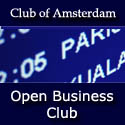
Welcome
to our bi-weekly ![]() Club
of Amsterdam Journal.
Club
of Amsterdam Journal.
Found today
searching Google News:
-
Google finds 46% profit rise as it cuts into rivals and lowers costs
-
"We've had numerous reports that Google.cn and other search engines have been blocked in China and traffic redirected to other sites," said a Google spokesperson in an e-mail. "While this is clearly unfortunate, we've seen this happen before and are confident that service will be restored to our users in the very near future."
-
Google Video Ads Showing Faster Growth Than Expected
-
Ballmer: Microsoft will dunk on Google…eventually
- Should The Government, Google, Or Another Company Manage Medical Records?
-
Viacom expressed reservations today at the Web 2.0 Summit about Google's plan to enter YouTube content into a database and give owners the chance to remove it.
Take a look at our
next Season Event
![]() the
future of Google -
October 25
the
future of Google -
October 25
NEW
LOCATION:
De
Industrieele Groote Club, Dam 27, Amsterdam
Felix
Bopp, editor-in-chief
| .Alexandria
burned - securing knowledge access in the age .of Google |
||
|
"We are all
worried about the new librarian. The Name of the Rose, Umberto Eco
|
||
| .Next Event | ||
|
|
||
| .Club of Amsterdam blog | ||
 |
September
6:
|
|
| .News about the Future | ||
 |
The Report analyses the latest trends in foreign direct investment (FDI) and puts a special focus in 2007 on the role of transnational corporations (TNCs) in the extraction of oil, gas, and metal minerals. As in previous years, World Investment Report 2007 (WIR07) presents the latest data on FDI and traces global and regional trends in FDI and in international production by TNCs. Global FDI inflows rose in 2006 for the third consecutive year. This growth was shared by all major country groups: developed countries, developing countries and the transition-economies of South-East Europe and the Commonwealth of Independent States . Rising demand for commodities was reflected in a steep increase in natural resource-related FDI, although the services sector continued to be the dominant recipient of FDI. Among the developing regions, FDI inflows to subregions such as North Africa, sub-Saharan Africa, West Asia, South Asia, East Asia, and South-East Asia were at record levels, as were foreign investment flows to transition economies. |
|
 |
Remarks from the conference:
“The very nature of international travel warrants an international
approach to establishing standards that safeguard passenger data,”
says Jennifer Stoddart, Canada’s Privacy Commissioner. “The
transfer of personal information among travel agents, carriers and
any number of domestic and foreign governments poses an ongoing
threat to the personal privacy of passengers.” |
|
| .N.I. Vavilov Institute of Plant Industry | ||
|
|
||
| Astrakhan
experiment station |
||
 |
The Station was opened in 1966 and is situated 14 km from Astrakhan. At this station the collections of rice, watermelon, melon, pumpkin, tomato, alfalfa, forage grasses and ornamental plants are studied. In particular, the station performs biochemical assessment of accessions and analyses of tomato physiology under saline soil conditions. | |
Daghestan experiment station |
||
 |
The Station was organised in 1969 on the Caspian Sea shore, 10 km from Derbent, and has been studying the collections of wheat and its wild relatives, barley, oat, vegetables, fruit plants and valuable local forms of grapevine. The climate provides a natural background infested by virulent races of brown, stem and yellow rust, which helps to make precise evaluation of accessions by their rust resistance. This station performs genetic analysis of wheat accessions in order to identify donors of male sterility and fertility restoring lines. | |
Far East experiment station |
||
 |
The Station (20 km from Vladivostok) has existed since 1929 and studies field crops, vegetables, fruits and berries, grapes, actinidia, aboriginal forms of plum, apricot, magnolia vine, honeysuckle and Amur grape. More attention is allocated to soybean, genetics proper of this crop and its resistance to fungi. The station breeds potato cultivars and introduces wild forage grasses into cultivation. | |
Yekaterinino experiment station |
||
 |
The Station was organised in Tambov Province (25 km from Michurinsk). It identifies sources of resistance to fungous diseases in leguminous crops, initial materials for breeding of nematode resistant potato with high content of starch. The station maintains duplicate collections of pea, lentil, vetch, small grains and perennial grasses. | |
Krymsk experiment breeding station |
||
 |
The Station was included in the Institute's network in 1935. It is situated in the town of Krymsk, Krasnodar Region, and studies the collections of green pea, sugar maize, tomato, pepper, eggplant, cucumber, apple, plum, peach, pear, apricot, strawberry and some other crops. It is involved in vegetable and sugar maize breeding programmes. | |
Kuban experiment station |
||
 |
The Station was established in 1924 in the steppe zone of Krasnodar Region. It performs studies of maize, sorghum, sunflower and castor oil plant, immunological research on wheat, barley, chickpea and sunflower, and on flax resistance to Fusarium wilt. The National Seed Store is situated on the territory of this station. It houses the base collection of the Institute within a temperature range from +4°C to -18°C. | |
Maikop experiment station |
||
 |
The Station was established in 1930. It has been studying the collections of cultivated and wild grasses, maize, Jerusalem artichoke, potato, winter rapeseed, and southern varieties of apple, pear, plum, sweet cherry and filbert. There is a quarantine nursery at this station. The station specializes in research on onion, pepper, eggplant, cucumber, cabbage, garlic, carrot and red beet. Heterosis hybrids of cucumber and tomato are bred at the station. | |
Moscow division |
||
 |
The Station was opened in 1957 in the town of Mikhnevo near Moscow. It has been working with cereals, legumes, forages, vegetables, potato and hop. The research on the effect of ionizing radiation and chemical supermutagens on the heredity of agricultural and horticultural crops is concentrated here. It also studies mutants and the prospects of their utilization in plant breeding, resistance of plants to diseases and pests, and physiology of environmental stress resistance. | |
Pavlovsk experiment station |
||
 |
The Station was organised in 1926 near St. Petersburg. Being one of the major stations of VIR, it studies perennial grasses and cruciferous tubers cultivated in the Non-Black-Soil area. There are over 3000 accessions of fruit and berry plants maintained in vivo in its gardens. More than 40 of these fruit samples have been commercialized. This station operates an experiment farm, a quarantine nursery and greenhouses. | |
Polar experiment station |
||
 |
The Station was opened in 1923 near the town of Kirovsk beyond the Polar Circle. It is a kind of natural laboratory for studying crop variability and their physiological characters under the growing conditions of the Far North. Cereals, vegetables, forage crops, berries and potato are studied here. The station is involved in biochemical, physiological, immunological and chemical weed control research. | |
Volgograd experiment station |
||
 |
The Station, established in 1932, is located in flood lands of Volga. It is comprised of the departments of vegetables, fruit plants, vegetable and potato seed production, and laboratories of biochemistry and technology, physiology and immunology. Plant genetic resources collections are studied under intensive irrigation conditions. This station possesses a big experimental farm and supplies scientific institutions with breeding materials. | |
Zeya experiment station |
||
 |
The
Station was established in 1985. This station collects old landrasces
and forms of cultivated plants and their wild relatives in the Far
East and Eastern Siberia. It provides complex study of the collected
samples and those from the Institute's collection in order to identify
the most promising accessions of cereals, vegetables, industrial crops,
small fruit plants and potato. Also, it renders scientific assistance
to local farms. |
|
| .Recommended Book | ||
 |
by Brian Winston Free expression is in trouble.It can no longer be certain of its best protection - "the general will of the people" - as Alexander Hamilton put it over two centuries ago. Today, the public, faced with the excesses of tabloid journalism and explicitness of all kinds in other media, appears no longer to be convinced that free expression is a crucial foundation of civil society. Yet, for all its faults, free expression under the law has, as Churchill once said of democracy, to be better than any alternative system. Messages is a search for the origins of media forms, from print and stage to photography, film and broadcasting. With a wealth of illuminating anecdotes and quotations, Brian Winston clearly and forcefully argues, in jargon-free language, that the development of mass media has been an essential engine underpinning all human rights and driving the Western concept of the individual. |
|
| .The Lighting Research Center | ||
|
Light
and Health Biological rhythms that repeat approximately every 24 hours are called circadian rhythms. Light is the main stimulus that helps the circadian clock, and thus circadian rhythms, keep a synchronized rhythm with the solar day. Humans need to be exposed to a sufficient amount of light of the right spectrum, for a sufficient amount of time, and at the right time, for our biological clocks to remain synchronized with the solar day. Otherwise, we may experience decrements in physiological functions, neurobehavioral performance, and sleep. Lighting characteristics
that are effective to the circadian system are different than
those effective to the visual system. In order to apply light
to mitigate the symptoms of Alzheimer’s disease, seasonal
affective disorder (SAD), jet lag, and sleep deprivation, we need
a better understanding of the quantity, spectrum, timing, duration,
and distribution of light that is effective for the circadian
system.
Daylighting Typical daylight harvesting systems include a photosensor paired with a dimming ballast to control fluorescent lighting, dimming the lights proportionally to the amount of daylight entering the work space. However, full-dimming ballasts are expensive and photosensors are usually difficult to program and install. The LRC set out to improve upon existing daylight harvesting technology and design a system that meets all of the following goals:
Technologies The LRC tests, evaluates,
and develops all types of lighting technologies in order to promote
lighting that is energy efficient, reliable, and easy to use.
|
||
| .European Futurists Conference | ||
|
ADVERT |
||
|
||
| .Agenda | ||
|
|
||
| October
25 18:30 - 21:15 |
and its impact on Media & Entertainment NEW LOCATION: De Industrieele Groote Club, Dam 27, Amsterdam |
|
| November
29 18:30 - 21:15 |
the
future of Sexuality Location: Waag Society, Nieuwmarkt 4, 1012 CR Amsterdam [Center of Nieuwmarkt] |
|
| January
31 18:30 - 21:15 |
the
future of Fashion Location: |
|
| February
28 18:30 - 21:15 |
the
future of NanoEnergy Location: |
|
| March
27 18:30 - 21:15 |
the
future of Ecological Architecture Location: |
|
| April
24 18:30 - 21:15 |
the
future of Money Location: |
|
| May
29 18:30 - 21:15 |
the
future of Children Location: Info.nl, Sint Antoniesbreestraat 16, 1011 HB Amsterdam [Next to Nieuwmarkt] |
|
| June
26 18:30 - |
Taste
of Diversity Location: |
|

 |
||
| |
||
| .Club of Amsterdam Open Business Club | ||
 |
Are you interested in networking, sharing visions, ideas about your future, the future of your industry, society, discussing issues, which are relevant for yourself as well as for the 'global' community? The future starts now - join our online platform ...: http://www.openbc.com/go/invuid/Felix_Bopp2 |
|
| .Contact | ||
|
||
| .Subscribe & Unsubscribe | ||
|
||
| m | ||
Copyright © 2002-2007, Club of Amsterdam. All rights reserved.








